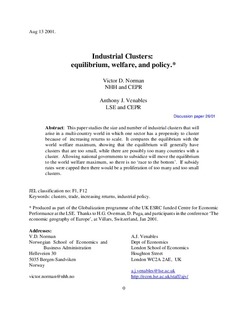| dc.contributor.author | Norman, Victor D. | |
| dc.contributor.author | Venables, Anthony J. | |
| dc.date.accessioned | 2006-08-10T11:04:33Z | |
| dc.date.available | 2006-08-10T11:04:33Z | |
| dc.date.issued | 2001-08 | |
| dc.identifier.issn | 0804-6824 | |
| dc.identifier.uri | http://hdl.handle.net/11250/162922 | |
| dc.description.abstract | This paper studies the size and number of industrial clusters that will
arise in a multi-country world in which one sector has a propensity to cluster
because of increasing returns to scale. It compares the equilibrium with the
world welfare maximum, showing that the equilibrium will generally have
clusters that are too small, while there are possibly too many countries with a
cluster. Allowing national governments to subsidize will move the equilibrium
to the world welfare maximum, so there is no ‘race to the bottom’. If subsidy
rates were capped then there would be a proliferation of too many and too small clusters. | en |
| dc.format.extent | 170028 bytes | |
| dc.format.mimetype | application/pdf | |
| dc.language.iso | eng | en |
| dc.publisher | Norwegian School of Economics and Business Administration. Department of Economics | en |
| dc.relation.ispartofseries | Discussion paper | en |
| dc.relation.ispartofseries | 2001:26 | en |
| dc.subject | clusters | en |
| dc.subject | trade | en |
| dc.subject | increasing returns | en |
| dc.subject | industrial policy | en |
| dc.title | Industrial clusters : equilibrium, welfare, and policy | en |
| dc.type | Working paper | en |
